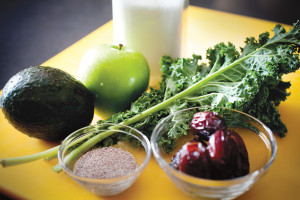Diet and nutrition play a big role in overall health and wellness, as well as combating specific illnesses and symptoms
by Emily Worts photography by Richard Galloway
 When television hosts like Marilyn Denis or Dr. Oz talk up today’s trendiest diet, it’s likely not a diet in the weight loss sense, claiming to help you lose 10 pounds in 10 minutes, but rather a diet of mindful eating: watching what we eat and how we eat it. Cutting out wheat and eating whole foods may help us get rid of our ‘wheat belly’, but changing what and how we eat can also help us feel more like we’re supposed to, not just lighter.
When television hosts like Marilyn Denis or Dr. Oz talk up today’s trendiest diet, it’s likely not a diet in the weight loss sense, claiming to help you lose 10 pounds in 10 minutes, but rather a diet of mindful eating: watching what we eat and how we eat it. Cutting out wheat and eating whole foods may help us get rid of our ‘wheat belly’, but changing what and how we eat can also help us feel more like we’re supposed to, not just lighter.
What many healthcare professionals, including naturopaths and holistic nutritionists, are advocating is a return to an approach to food that supports the way our bodies were built to eat. Some praise the Paleo diet (the ancient diet of wild plants and animals consumed by ancient hominid species), some advocate gluten-free, but essentially the gospel is the same: getting back to a more primal way of eating can help with everything from osteoarthritis to rheumatoid arthritis, fibromyalgia, allergies, digestion, fatigue, irritable bowel syndrome, Crohn’s and Colitis, bloating, fertility, even eye problems and skin irritations. “Change how you eat and you can change how you feel,” says Collingwood naturopathic doctor Aranka Jones. “Food is medicine.”
Lifestyle medicine – using lifestyle interventions like diet, exercise, and stress management in the treatment of disease and ailments – is gaining momentum. Nutrition has become a primary lifestyle medicine in the naturopathic doctor’s tool kit, and a change in diet is prescribed more consistently than any other methodology.
“In some cases it’s very simple to make drastic changes,” says Jones of adopting an attitude of awareness when it comes to what and how we eat. In Western medicine, diet is often overlooked as a primary solution. The body is a mystery and it’s often hard to identify exactly what ails us. What we put in our bodies confounds the problem even more. For many healthcare professionals who do look at diet, it can be a real challenge to identify specific food triggers which cause discomfort.
“People come to me because they react to something but don’t know what they’re reacting to,” says Regina Featherstone, a holistic nutritional consultant based in Wasaga Beach. To help solve the mystery, Featherstone’s clients fill out intensive lifestyle intake forms, often revealing hidden issues, like emotional stressors, that can affect how we feel. She then checks for food intolerances through muscle tests on over 100 foods.
The problem for many people is what to do with this information once they have received it. Getting people to change their habits, especially when it comes to food, is one of the greatest challenges healthcare professionals face. Changing what we eat, how we manage our stress, even how we breathe, may be better for us than swallowing a prescription pill three times a day, but it’s a lot more difficult.
For this reason Featherstone doesn’t just recommend what to eat; she advises how to eat with a weekly meal plan. “It’s not always easy to get people to change,” says Featherstone. “I had a client who didn’t want to change. He got very upset and I never thought he would come back. It seems like such a big task but people CAN change their habits.” Her client did come back, and the changes she suggested, much to his amazement, worked. Within two to three weeks, Featherstone often sees improvements in clients who follow specific dietary directions, which usually include an eliminating certain foods.
Elimination diets use trial and error to identify specific allergies and intolerances, most commonly gluten, dairy, egg, and soy. It could take two weeks to two months to see any change, but it’s worth it. A healthy diet of the right foods will give our bodies the nutrients they need to perform physically, maintain wellness,
fight disease and feel better.
“We are like machines,” says Featherstone. “If we don’t give our bodies good fuel ,we are not going to perform as well.” In most cases it is harmless to experiment with elimination diets, removing certain foods and gauging how this makes us feel, without consulting a health care professional. But in specific cases, (for example if you are on blood pressure medication), it is wise to have some guidance, says Featherstone. In addition to gluten, dairy, egg and soy, Featherstone commonly recommends clients stay away from food colouring, deep-fried foods, processed carbohydrates and genetically modified organisms (she has some clients who react to GMO wheat but not organic wheat).
With these recommendations, Featherstone is taking mindful eating one step further, maintaining that we must curb our addiction to ‘cheap food.’ North Americans, in general, are not only addicted to processed foods, but to extremely cheap food, which is cheap for a reason: it’s full of inexpensive fillers, preservatives “We don’t really value good quality food here,” says Featherstone, who was born and raised in Germany. “I was just in Europe and it was very inexpensive to buy a turkey breast and very expensive to buy hot dogs; it was very inexpensive to buy vegetables and very expensive to buy cereal.”
Here the opposite is true. Sugary cereals are always on sale, and it costs more than a dollar to buy an Ontario apple verses 75 cents to buy a bag of chips. A lack of knowledge in the kitchen and a fast-paced lifestyle also mean it’s more likely parents will boil up pasta or order a pizza for family dinner than take the time to cook a healthy, balanced dinner from scratch. “Everything needs to be done as quickly as possible,” says Featherstone.
“People have forgotten how to cook.” Featherstone became a nutritionist after her young daughter was diagnosed with rheumatoid arthritis at one-and-a-half years old. The doctors said that by six she would be in a wheelchair. “She was 21 pounds at a year and dropped to 15 pounds at a year-and-a-half,” recalls Featherstone. “She was vomiting all the time. I did all kinds of reading and changed her diet significantly. Today she is a 16-year-old girl who can do whatever she likes, with no medications and no problems with her joints.” Featherstone has a host of ‘miracle’ stories, many of which come back to a change in diet.
“I had an 83-year-old gentleman come to me with such major fatigue that he was hospitalized. We changed his diet and he is now busy in his workshop and cutting his grass.” She has even seen eye problems clear up from taking gluten out of a diet. “I’ve seen people cut down on gluten and starchy food and their vertigo goes away,” says Featherstone. “It’s just a side effect.”
More and more, the harmful side effects of wheat, and specifically gluten, are being recognized by healthcare professionals. As a species we have only been eating wheat and other grains, as a staple in our diet, for about 10,000 years (some believe we have been consuming wild grains for much longer, 100,000 years, but still a blip on an evolutionary scale considering the earliest documented member of the genus homo first shows up 2.3 million years ago). Less than one-tenth of one per cent (0.001 per cent) of our genes have changed in the last 10,000 years, which means our bodies haven’t adapted to our new grain-rich diet and sedentary lifestyle, leading to a host of different reactions that can make us feel terrible.
If cutting out gluten can clear up everything from eye problems to helping with fertility, it should come as no surprise that marketing companies are jumping on the gluten-free band wagon. Gluten-free products are showing up everywhere. We can get gluten-free brownies, bread, pasta and potato chips. Even consumables that have always been gluten-free, like hummus, now carry gluten-free labels. “I remember doing my training and laughing a bit about the gluten-free diet being the solution to every problem,” says Aranka Jones. “It’s certainly not the solution for everything, but it can often be a part of it.”
The gluten-free phenomenon has been criticized as a fad; however, it has also been proven to be a better way to eat, if you do it right. Jones recommends some guidance from a healthcare professional before embarking on any major diet shift and to not get sucked in by all the products out there. “Gluten-free products can be a big problem for a lot of people,” says Jones. “They are not as healthy as we are led to believe. A chip is still a chip, even if it’s gluten-free.” Gluten-free products and substitutes often rely heavily on highly processed grains like rice and corn, which can have a higher glycemic index than white table sugar.
“The larger battle is to consume more whole foods,” says Jones. “Treat any processed food, – even if it’s gluten-free – like it’s a treat, not something you would consume on a daily basis.” Jones challenges her clients to make gluten-free brownies from scratch using nuts and seeds and no flour at all, rather than making them gluten-free with wheat substitutes. “The larger problem is the grain addiction we have,” says Jones.
Dealing with this addiction means changing how we look at the food we eat and how we eat it. Taking out the grain products means replacing them with more meat, seafood, vegetables, roots, and fruit; having rice instead of rolls at dinner; using a leafy green to wrap up lunch instead of a wheat tortilla; eating a hamburger without a bun but with everything else. This is where Claire Shortt got stumped. “I know kale is good for me,” says Shortt. “But how do I eat kale and make it taste good?”
To help bridge the gap between knowing and doing, Shortt signed up for cooking classes catering to people with food sensitivities, hosted by Aranka Jones and culinary nutritionist Jordan Swartz. “I have some health issues, but no big ones,” explains Shortt. “But I know there are so many illnesses caused by what we eat. I needed a little guidance to help me from getting sick. This is preventative for me.”
She admits that many of the foods she grew up eating are simply not good choices, especially as we age. “We can’t eat like that and be healthy,” she says. “The food has changed and our lifestyle has changed; we’re way more sedentary.” For $75 each, Shortt and a class full of others have access to a naturopath and a nutritionist for two-and-a half hours in Jones’ and Swartz’ Naturopathic Kitchen. Students ask all the questions they want including why mushrooms help boost immunity and what knife to use when chopping garlic. “It is more than just the recipes,” says Shortt, adding that her grocery list has changed dramatically. However, she admits it’s been difficult. “It’s hard to go from eating a North American diet with a lot of wheat and a lot of fat and things that aren’t good for you, to a completely healthy diet,” she says. To help clients gain control of changing diets, Jones, along with Swartz, started offering cooking classes in the spring of 2012. They run two classes a month from May through December.
“I’ve always shared recipes and let people know that there are certain foods that can help certain ailments,” says Jones. “The cooking classes come from that.” Nature gives us what we need when we need it, says Jones. In the spring, when it is important to detox to boost vitality after a long winter, there is an abundance of greens which are good for detox. In the fall we have squash and mushrooms, foods that strengthen and modulate the immune system. Building a connection with our food by growing a vegetable garden or getting to know local farmers can help build excitement around food and new ways to eat, says Jones. Relying more on fresh produce and protein will help reduce our reliance on processed foods.
“The more control I have over my food production, the more I enjoy it,” she says. “The more connected I become, the greater my sense of well-being.” Five years ago, Jenn Croft gave up a pension, benefits and good pay after 10 years of cooking in a long-term care facility, to begin a dietary crusade that would help her constant struggle with irritable bowel syndrome (IBS) and her young son’s diagnosis of type one Diabetes and Celiac disease. Croft, a papered chef, could no longer taste the food she was preparing for others because she was gluten intolerant.
“I lost my passion,” she says. “The food I was supplying didn’t make sense.” To add to her predicament, there wasn’t much on the grocery store shelves her son could eat. With her background in catering to special diets she decided to start her own business, Creative Choices, a bakery and kitchen specializing in prepared meals and bakery items for people with food intolerances. “I felt I had to do this; I couldn’t sit back and wait,” says Croft. “It’s been quite phenomenal.”
In October 2012, Croft won the Meaford Dragon’s Den challenge, which resulted in community support, several connections, marketing help and a few pieces of equipment. All five judges enthusiastically bought into her idea, each contributing $500. Croft caters to everyone from infants to seniors. She has been cooking for one five-year-old client since he was a baby. Her recipes are allergen-free, not just gluten-free, cutting out egg, dairy, soy and wheat. “Someone can walk in with a food intolerance or food restrictions and I can create a menu that works for them,” explains Croft. “We offer a lot of support when you walk through the door. We have your needs on file.” Croft makes real food, not the processed alternatives that are cluttering up grocery store shelves. Switching up processed foods for whole foods, along with a commitment to moderation and diversity in our diets, will make us feel better, she says.
With the advice of naturopaths and nutritionists and the instruction and skills of good chefs, we can successfully fight our addiction to grains and to cheap, processed food. But it will take a lot of hard work, and like any withdrawal, it will be shaky. More than likely, just as people begin to embrace gluten-free the next food trend will appear around the corner. The grain-free train is the latest diet to hit the track, forcing people to look even deeper at how they eat. But for now the fixation on eating the foods we were built to eat means increased food awareness and a more healthy diet. The bottom line is, you get more nutrients by replacing wheat and other processed foods with protein, veggies, fruits and nuts. By embracing mindful eating, we may be, without knowing it, reverting to a more primal way of eating. The challenge is to stick with it.












